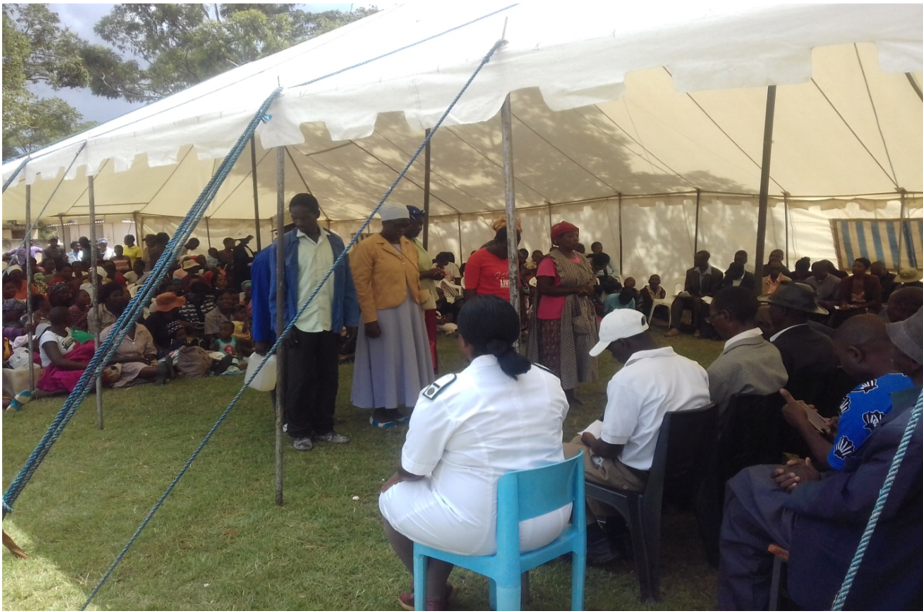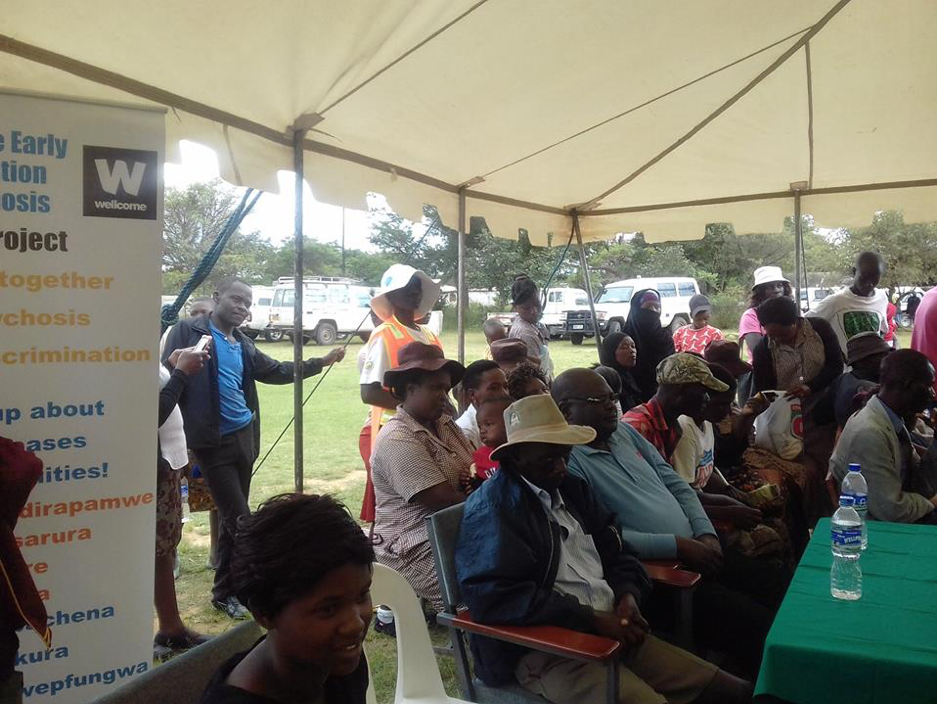“Z Factor” set out to engage communities on mental health stigma and discrimination, as well as health seeking behaviour using creative visual methods. Drama, with its subcategories of music, dance and poetry, was used as it is culturally acceptable and enjoyed in Zimbabwe. Participants for the drama plays were young adults, who are often affected the most by psychosis. They were drawn from all groups in society. Community mental health service providers, such as nurses, faith healers and traditional healers watched the dramas and took part in stakeholder workshops and collaborative focus group discussions. The pilot project was implemented in Rusike and Chinyika wards of rural Goromonzi, between December 2017 to May 2018.

“Z Factor” Implementation Framework
In Zimbabwe, there are taboos and negative perceptions associated with mental illness. When it is discussed it is often associated with evil spirits and curses as punishment for murder or other deviant behaviours in society. As a result, people with mental illness are stigmatised and discriminated against. The Z Factor project therefore, avoided using traditional awareness raising activities, through public education forms of engagement for example. It instead adopted and adapted participatory action research as a way of ensuring active participation of communities. It used the following approaches:
a) A psychosis themed drama competition, with prize money, to gather communities.
b) Discussion workshop on the key themes brought out in the dramatisations. Discussions started as soon as each drama ended.
c) Actors in the dramas were not given scripts or told what to do or say. They had complete control and autonomy on their performance. They reflected on what was actually happening in their villages.
d) Community-based treatment providers (traditional healers & herbalists, Christian pastors & prophets, indigenous faith healers and Islamic herbalists) interacted with biomedical service providers and researchers to identify suggestions for further exploration in which the two care pathways could collaborate.
e) An engagement platform for information sharing between project implementors and the community. It provided an opportunity for the community to reflect upon their mental health perceptions and on how they act as barriers or facilitators of good health-seeking behaviours.

Z Factor Aims and Objectives
A community focused Early Intervention in Psychosis programme (ZimEIP) was piloted in rural Zimbabwe in October 2016. ZimEIP came across a general lack of accurate biomedical information regarding psychosis and its treatment. Understanding was generally compounded by the traditional and religious explanatory models which act as barriers towards opening up about mental illness. These beliefs largely attribute the causes of psychosis to witchcraft and evil spirits which in turn fuels stigmatisation and poor help seeking behaviours in communities.
Z Factor pilot project therefore, aimed to provide a platform that grabbed public attention, opened up mental health conversations and sparked public debate about psychosis. It wanted to do this in ways that made communities feel comfortable expressing their true beliefs and experiences.

Activities
Z Factor piloted drama as an effective tool to incentivise the community to open up about psychosis and to overcome the near taboo status ascribed to mental health. The programme engaged two audiences; the local community and mental health service providers. By engaging mental health service providers, we wanted to explore possible ways of treatment collaboration to eliminate treatment delays caused by the mistrust and tension that exist between biomedical and traditional/faith-based service providers. We hope that this project will be the first of many, and that it will be the starting point of closing the gap for a) treatment delay and, b) pathways to care.
The drama competitions were open to everyone by audition. Adolescents, young adults and their potential support networks were invited to take part. They competed within and between wards/villages. Break-out groups ran parallel to the competitions - community members, stakeholders and biomedical researchers had in-depth discussions on themes unearthed by the dramas. The drama competitions attracted different parts of the community to watch. They were entertaining and informative and opened up the conversation about psychosis. The workshops provided a platform for further community engagement.

Evaluation and Lessons learnt
The project employed participatory methods throughout the process from planning to monitoring project activities. Project planning workshops with key community stakeholders, such as traditional leaders, village elders, government line ministries, creative arts practitioners and religious groups’ leaders, were used as a platform for coming up with goals and strategies to achieve the overall project aims. A logical framework approach was therefore used for planning, monitoring and evaluation. 1,905 people participated in the community events.
The dramas and workshops touched on issues such as knowledge on the negative impact of psychosis stigma and discrimination, early detection and psychosis treatment seeking as well as exploring a sustainable way of collaboration in treatment provision by the traditional/faith based and bio-psychosocial treatment providers. As a result, the project implementers’ understanding of community perceptions about psychosis increased. This knowledge will be useful in informing future projects and health research strategies that will involve communities as active participants in science research.
The project however, did not have as good stakeholder and project participant geographical mapping as it should have had. It relied more on the information from community gate keepers. This resulted in a significant number of participants having to travel for 40 km to attend workshops as activities were carried out at a ward level. This was a disadvantage to willing participants who couldn’t come due to transport challenges. For future projects of a similar nature, it is imperative to carefully consider issues of geographical accessibility.

Next steps and directions
Current efforts are ensuring that the project team shares the findings and lessons learnt from the Z Factor project, not only with the community of implementation, but with public engagement practitioners, mental health researchers and policy makers. We therefore hope to publish our findings such as our methods and evaluation in open access journals such as Wellcome Open Research.
Though Z Factor saw the participation of different age groups, it was felt by both community participants and the project team that a more youth biased version of Z Factor that targets school children and their teachers will prove useful. Young people are equally affected by mental health illness and stigma. We intend, therefore, to develop a school’s engagement approach that specifically focuses on 13 to 18-year olds.
Building on the lessons learnt from the Z Factor project pilot, project implementors are working on an adapted and refined version of the Z Factor project to be implemented in rural as well as urban Zimbabwe. As well as further exploring collaboration between traditional/faith based and biomedical services.
Supported by the Wellcome Trust
-
1: Community mental health service providers, such as nurses, faith healers and traditional healers were also engaged through separate stakeholder workshops and focus group discussions as well as watching the community dramas. The stakeholder workshops and focus group discussions were conducted once every month throughout the project life. This engagement was mainly targeted at creating a collaborative environment in which these different service providers could work together rather than against each other as is the current situation in Zimbabwe.
2: The biggest challenge in Zimbabwean mental health sector is treatment delays and duplication of services. This is largely due to the lack of collaboration between biomedical services and traditional/faith-based services. Communities are encouraged to seek biomedical services only and alternative medicine is not only looked at as primitive but is even seen as dangerous. This has created tension between these two service providers who are often hostile towards each other. As a result service users do not benefit from a clearly laid out referral pathway from one provider to the next resulting in service users failing to disclose concurrent services they would be receiving from traditional/faith-based service when they visit biomedical services. Further, because of the lack of collaboration, service providers take as long as more than a year treating a client without referring them to the next service provider. This is especially pronounced between traditional and biomedical service providers who do not see eye to eye. The engagement was, therefore, an attempt to provide a platform where service provider tension could be addressed to foster a spirit of collaboration for the benefit of service users who are afraid of disclosing receiving services from one for fear of being verbally primitive for seeking treatment from primitive and dangerous sources.
By engaging mental health service providers, we wanted to explore possible ways of treatment collaboration to eliminate treatment delays caused by the mistrust and tension that exist between biomedical and traditional/faith-based service providers. -
Thank you for sharing the fantastic article Denford.
1. It would be great to know more about how the community mental health service providers, such as nurses, faith healers and traditional healers were engaged.
2. Also, how did engaging mental health service providers allow you to explore possible ways of treatment collaboration to eliminate treatment delays?

Please Sign in (or Register) to view further.